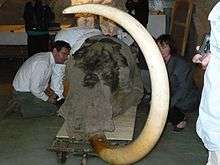Yukagir mammoth
The Yukagir Mammoth is a frozen adult male woolly mammoth specimen found in the autumn of 2002 in northern Yakutia, Arctic Siberia, Russia, and is considered to be an exceptional discovery.[1] The nickname refers to the Siberian village near where it was found.[2]
Discovery
The head of this specimen, entirely covered with skin and very well-preserved, was first discovered in 2002. After hearing about the discovery, a polar explorer carried out the expedition with his team to extract the remains from the permafrost. One of the members of the team was the French polar explorer, "Mammoth-Hunter" Bernard Buigues, known for carrying out expeditions to the North Pole, Siberia since the 1990s.[1] It took three excavation trips to gather and put the Yukagir fossil together. Although mammoth fossils are not a rarity, few are as notable as this specimen.[3]
The discovery of the Yukagir Mammoth, is described as one of the greatest paleontological discoveries of all time as it revealed that woolly mammoths had temporal glands between the ear and the eye[1] and the well-preserved remains of the Yukagir Mammoth, such as the foot, shows that the soles of the feet contained many cracks that would have helped in gripping icy surfaces during locomotion. Like modern elephants, woolly mammoths were Paenungulata, meaning they walked on their toes and had large, fleshy pads behind the toes. Among other discoveries, the Yukagir Mammoth showed that the species had suffered from spondylitis in two vertebrae, and osteomyelitis which is also known from some other specimens. Several specimens have healed bone fractures, showing that the animals had survived these injuries.[4]

The Yukagir mammoth's permafrost tomb preserved its head, tusks, front legs, and parts of its stomach and intestinal tract. From its bones and enormous tusks, the scientists who rushed to the site (including mammoth experts Dick Mol and Larry Agenbroad) guessed that the woolly mammoth was an old male that when alive stood over nine feet tall at the shoulder and weighed four to five tons. Furthermore, scientists were able to discover that the main component of the Yukagir's final meal was grass, including stems from the family Poaceae. Remarkably, like many of the dung's floral remains, the stems have retained their color and shape ever since the woolly mammoth tore them from the tundra roughly 22,500 years ago.[5] Based on the Yukagir Mammoth's last meal, scientists were enabled to discover facts about the elephant's ancestors and conduct an environmental reconstruction[6] and fungi's importance in the process of nutrient cycling in the mammoth steppe.[7]
The following types of research were agreed upon at the meeting of the Scientific Council:[8]
- Geological and pedological surveys of the site, as well as research on the process of fossilization;
- Research on the external structures of the mammoth, as well as on the internal structures using nondamaging methods;
- Histological, cytological, and genetic research on the mammoth's soft tissue;
- Paleobotanical and paleoclimatologic analysis;
- Microbiological research on the soil and the inside of the mammoth.
Exhibitions
Since the Yukagir Mammoth has been found, it has been transported globally for informative and educational purposes. The specimen was displayed in an effort to understand the link between life and the global environment with the theme of the Expo - "Nature's Wisdom." To keep it preserved, the exhibition room needed to be kept at -15 °C. The 2005 World Expo was held in Aichi, Japan at took place on November 17–18, 2005.[9]
References
- 1 2 3 Mol, Dick; Shoshani, Jeheskel (Hezy); Tikhonov, Aleksei; GEEL, Bas van; Lazarev, Peter; Boeskorov, Gennady; Agenbroad, Larry (2006). "The Yukagir Mammoth: Brief History, 14c dates, individual age, gender, size, physical and environmental conditions and storage." (PDF). Scientific Annals, School of Geology Aristotle University of Thessaloniki (AUTH). 98: 299–314. Retrieved 2014-06-12.
- ↑ "NOVA | scienceNOW | A Mammoth Waste of Time image 2 | PBS". www.pbs.org.
- ↑ "From the Siberian steppes to the Aichi Universal Exhibition in 2005". Mammuthus.org. Retrieved 16 June 2014.
- ↑ Lister, Adrian (2007). Mammoths - Giants of the Ice Age. London: Frances Lincoln. pp. 108–111. ISBN 978-0-520-26160-0.
- ↑ Tyson, Peter. "A Mammoth Waste of Time". Nova Science Now. PBS Online. Retrieved 12 June 2014.
- ↑ van Geel, B.; Aptroot, A.; Baittinger, D.; Mol, D.; Pals, J.P.; Shoshani, J.; van Reenen, G.B.A.; Bull, I.; Evershed, R.; Nierop, K.G.J.; Tikhonov, A.; van Tienderen, P.H. (2005). "Environmental reconstruction based on the Yukagir Mammoth's last meal". Japan Association for the 2005 World Exposition: 13–14.
- ↑ Aptroot, Andre; van Geel, Bas (2006). "Fungi of the colon of the Yukagir Mammoth and from stratigraphically related permafrost samples". Review of Palaeobotany and Palynology. 141 (1-2): 225–230. doi:10.1016/j.revpalbo.2005.04.006.
- ↑ "Survey of the Discovery Site of the Yukagir Mammoth (June)". Japan Association for the 2005 World Exposition. Retrieved 16 June 2014.
- ↑ "FOAM USED IN THE PRESERVATION OF THE YUKAGIR MAMMOTH". Retrieved 16 June 2014.